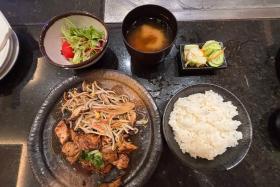Savour traditional satay lok lok before it's gone
Experience the last satay lok lok hawker stall in Singapore
Nothing beats the taste of traditional satay lok lok.
Hock Leng Satay Bee Hoon Lok Lok is known to be the last such hawker stall in Singapore offering it, and I have to give due respect for the pleasure it has given us.
The dish has roots in Indonesia and Chaozhou, China.
Long ago, The Teochews sailed to Indonesia seeking better fortunes, but many could not cut it so they returned with newfound flavours.
They called the satay sauce sha cha jiang (literally sand tea sauce in Mandarin) in Chaozhou and had it with noodles and beef balls.
But the Teochews in Singapore and Malaysia engaged with it differently, turning it into a skewered hotpot dish.
Various cuts and slices of meats, vegetables, seafood, mushroom, meatballs and tubers are skewered, cooked in hotpot and dunked in a Chinese-style satay sauce, punctuated with five spices and a rich seafood stock.
In Malacca, you cook them directly in satay sauce, but the sauce will burn a pot base if you do not stir it constantly and control the heat.
They have servers that do it for you.
In labour-starved Singapore, it is do-it-yourself, and you boil the skewers in soup.
Mr Hay Choo Seng and his wife have been hawking this street food icon for more than 50 years in the Old Airport Road vicinity.
And today, if they choose to exit the scene and retire, the last satay lok lok hawker stall here will be no more.
"No one wants to take over, and this is tough work," Mr Hong told me.
REST
They hand-skewer more than a thousand sticks of various ingredients each day, which is why this ageing hawker takes three days off a week "to rest".
I ordered the medium set at $25 (good for three hungry foodies) and two plates of satay beehoon.
You can tell just how distinctly they set themselves apart from the buffet-style satay lok lok restaurants.
First and foremost, the sauce has soft hints of heat and is savoury, thick and rich.
The genius is in the accents of tee po, or dried and roasted sole fish bones.
As for the ingredients, the items are fresh - such as the fish, liver, pork, cockles, prawns, cuttlefish, mushrooms, quail eggs and kangkung.
The bonus is the satay beehoon, a simple platter of blanched beehoon with bean sprouts and tau pok slathered in that glorious satay sauce.
Remember, you are experiencing a slice of our heritage food culture, so take your time and enjoy it.
Cook the skewered ingredients thoroughly and devour, washing it all down with Chinese tea, kopi-o or a fresh soursop drink.

K.F. Seetoh, the founder of Makansutra, dabbles in street food businesses like Food Markets and has his own TV shows on cable. He publishes food guides and online content. He is also the creator of the World Street Food Congress. Follow him on Facebook, Twitter and Instagram.
Get The New Paper on your phone with the free TNP app. Download from the Apple App Store or Google Play Store now





